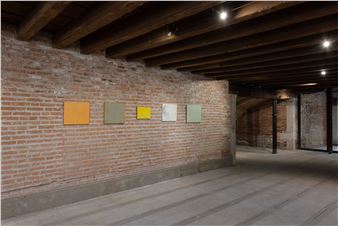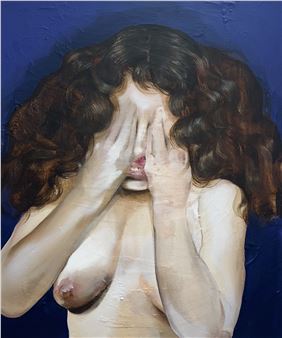Mattia Moreni: Objects and Things think in silence
"Far from the useless academicisms that await even the boldest at every turn, Moreni lives intensely, totally, what for him is the pictorial adventure; and never has the term adventure been more fitting. His work questions and thus challenges itself at the only possible level of the current human condition." (Michel Tapié, exhibition cat. XXX Venice Biennale, 1960, p. 103). The exhibition at ACP - Palazzo Franchetti highlights key moments in this "adventure," offering the opportunity to admire undisputed masterpieces from Moreni's oeuvre, such as A tutti i maldestri del mondo: Amitié (1960), presented at the Venice Biennale that year and referenced in Tapié's quote above. This was the first painting in which the artist incorporated a written word into the composition. From this moment, Moreni developed his distinctive practice of integrating painted words directly onto the canvas to reinforce and enhance his acute reflections.
This journey underscores the contemporary relevance of Moreni's research. "Objects and Things Think in Silence" is not a quote from a recent text on artificial intelligence but the title of a chapter from The Rational Absurd Because Necessary, the second volume of the artist's monologues published in 1989, following Fluid Ignorance from 1979. The exhibition dedicates considerable attention to the final phase of the artist's work, which focuses on the decline of contemporary society. This reflection dates back to his "Watermelons" cycle, interpreted both as a regression of the species in the man-computer dialectic and as a regression of painting itself. Moreni emerges as one of the most aware and explicit critics of an impending "regressive" fate and the threats posed by computerized civilization, which he believed would not spare the art world. In the painting Umanoide tutto computer via internet.. (All Computer Humanoid via Internet..) (1996), we read: electronics advancing / will prevent us from recognizing / so-called artists working / with computers with another mind for / another way of seeing: the revolution / of life without ideals. WHY? These reflections remain strikingly relevant today, offering a privileged perspective on the present from an artist whose finely tuned sensibility allowed him to interpret the historical significance of a revolution that, in his time, was only beginning.

"Far from the useless academicisms that await even the boldest at every turn, Moreni lives intensely, totally, what for him is the pictorial adventure; and never has the term adventure been more fitting. His work questions and thus challenges itself at the only possible level of the current human condition." (Michel Tapié, exhibition cat. XXX Venice Biennale, 1960, p. 103). The exhibition at ACP - Palazzo Franchetti highlights key moments in this "adventure," offering the opportunity to admire undisputed masterpieces from Moreni's oeuvre, such as A tutti i maldestri del mondo: Amitié (1960), presented at the Venice Biennale that year and referenced in Tapié's quote above. This was the first painting in which the artist incorporated a written word into the composition. From this moment, Moreni developed his distinctive practice of integrating painted words directly onto the canvas to reinforce and enhance his acute reflections.
This journey underscores the contemporary relevance of Moreni's research. "Objects and Things Think in Silence" is not a quote from a recent text on artificial intelligence but the title of a chapter from The Rational Absurd Because Necessary, the second volume of the artist's monologues published in 1989, following Fluid Ignorance from 1979. The exhibition dedicates considerable attention to the final phase of the artist's work, which focuses on the decline of contemporary society. This reflection dates back to his "Watermelons" cycle, interpreted both as a regression of the species in the man-computer dialectic and as a regression of painting itself. Moreni emerges as one of the most aware and explicit critics of an impending "regressive" fate and the threats posed by computerized civilization, which he believed would not spare the art world. In the painting Umanoide tutto computer via internet.. (All Computer Humanoid via Internet..) (1996), we read: electronics advancing / will prevent us from recognizing / so-called artists working / with computers with another mind for / another way of seeing: the revolution / of life without ideals. WHY? These reflections remain strikingly relevant today, offering a privileged perspective on the present from an artist whose finely tuned sensibility allowed him to interpret the historical significance of a revolution that, in his time, was only beginning.
Artists on show
Related articles
Perfectly aligning with the theme of the 19th International Architecture Exhibition.

 ARTISTS
ARTISTS











